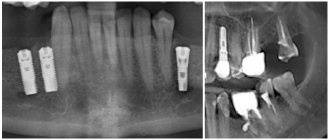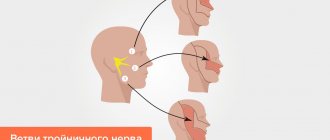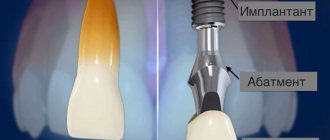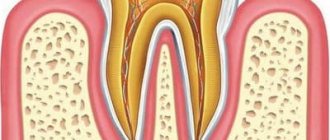It is a common belief that people with implants should not have an MRI. In fact, this was the case several decades ago, when patients were fitted with prosthetics made of steel, nickel and cobalt. In those years, magnetic resonance imaging could cause serious harm to human health.
TBS implant.
Let's be clear from the beginning that people with implants, pins, screws, retaining plates, breast implants, and dental implants CAN have an MRI.
What implants can be used for MRI?
MRI is allowed for people who have undergone hip or knee replacement. It is important that the endoprosthesis or fixation for osteosynthesis is made of metals or ceramics with low magnetic susceptibility. This avoids displacement or overheating of the structure during the examination.
Knee endoprosthesis.
People with hernia mesh, dental, breast and joint replacements are also allowed to have an MRI. All these implants are made from materials that do not interact with the magnetic field. This makes the study safe. However, you should consult a specialist before an MRI. The doctor will assess the possible risks and recommend the necessary precautions.
Minimally invasive endoprosthetics in the Czech Republic: doctors, rehabilitation, terms and prices.
Find out more
Is it possible to do MRI with endoprostheses and other implants?
What to do if the patient has various types of implants right in his body? First of all, this must be reported to the specialist conducting the examination, since many metals are ferromagnetic and can shift in the body under the influence of a magnetic field.
For an MRI with a steel wire in the body, everything is not so simple. Iron causes the magnetic field to deviate from a given direction, which leads to distortion of the resulting images and the appearance of artifacts (defects) on them. In addition, the needle can heat up, creating unpleasant sensations for the patient.
Also, the answer to the question whether it is possible to do an MRI with an endoprosthesis depends on what material it is made of. If it is titanium, then there are no restrictions. If it is made of ferromagnetic materials, then this is a contraindication for research. You can find out exactly what metal the implant is made of in the design passport, which is issued to the patient after prosthetics.
Interaction of different metals with a magnetic field
Different metals tend to interact with magnets differently. Some of them are attracted to it, others are repelled, and others do not react at all. All three types of metals are used for the manufacture of endoprostheses.
Table 1. Metal classes.
| Class | Representatives | Description |
| Diamagnets | Copper Zirconium Silver Zinc | They have negative magnetic susceptibility. This means that when interacting with a magnetic field, they repel rather than attract. |
| Paramagnets | Titanium Tungsten Aluminum Tantalum Chrome Molybdenum | These metals are characterized by the presence of low magnetic susceptibility, independent of the magnetic field strength. Paramagnetic prostheses usually tolerate the MRI procedure well and do not move or heat up. |
| Ferromagnets | Iron Nickel Cobalt Steel | They have high magnetic susceptibility, depending on the magnetic field strength. Implants containing large amounts of these metals may become dislodged or become hot during an MRI scan. |
Is it possible to do an MRI with iron crowns?
If you have old-style crowns made of iron, you cannot screen the brain and heart. The metal heats up significantly, which causes severe pain in the patient, deformation of the metal structure - the integrity of the implants may be compromised or they may fly off the teeth.
With crowns and dentures with metal-ceramics, screening of the brain and heart area is allowed, but there is a high probability of an unreliable result due to a distortion of the response to magnetic field signals.
Regardless of the type of alloys of crowns and prostheses, it is allowed to conduct MRI of the lumbar spine, abdominal organs and retroperitoneal space, pelvic region and extremities in closed-type devices.
When installing pins, high-strength titanium implants are often used. Their presence does not affect the reliability of the examination results; moreover, the size of the pins is so small that the magnetic field does not have any significant effect on them.
Metal crowns made of polymer alloys also do not distort magnetic field signals, however, you should check with your dentist about the possibility of conducting an MRI. Some structures heat up, so the procedure will cause significant discomfort to the patient.
If a patient has dental bridges installed, then they probably contain separate parts - pins, plates, screws of various sizes. For their manufacture, diamagnetic, ferromagnetic and paramagnetic materials are used - cobalt, iron alloy and nickel, which react differently to magnetic field signals. Therefore, you should check with your dentist what materials were used to make the prosthesis, and notify the tomography specialist - he will decide on the possibility of conducting an MRI.
Composition of modern endoprostheses
All plates, pins and endoprostheses, which are used in modern traumatology and orthopedics, consist of a variety of alloys. Note that different implants contain different amounts of paramagnetic and ferromagnetic materials. The properties of each endoprosthesis, pin or plate depend on the composition.
Not all prostheses are 100% metal. Most of them contain ceramics or polyethylene. The latter does not interact with the magnetic field, therefore, it does not in any way affect the MRI results and the course of the procedure. However, ceramics most often contain aluminum oxide, which still has a certain magnetic susceptibility.
Destroyed components of the hip joint implant.
Possible combinations of materials in endoprostheses:
- ceramics + ceramics;
- ceramics + polyethylene;
- metal + polyethylene;
- metal + ceramics;
- metal + metal.
Fact! Plates and pins for fixing bone fragments are made of metal alloys. The same applies to external fixation devices (Illizarov type) and clips that are placed on vessels.
Composition of artificial joints:
- cobalt;
- chromium;
- molybdenum;
- titanium;
- zirconium;
- tantalum;
- niobium.
Having familiarized yourself with the composition, you can understand how it will behave in a resonant tomograph. The magnetic properties of each endoprosthesis are determined not only by the material from which it is made, but also by its shape and size. Steel pins and plates longer than 20 cm can heat up above the permissible limit.
Fact! Products containing large amounts of nickel and cobalt interact especially actively with a magnetic field. This means that diagnostics with such endoprostheses should be performed with extreme caution.
How does MRI affect implants?
Since the study is based on the use of magnetic vibrations, most patients have a question: “Is it possible to undergo tomography with dentures?” Innovations regularly occur in the dental field, prosthetic technology develops and new materials appear to create a beautiful smile. Previously, dental crowns were made only from copper or gold, but today patients have access to a large range of materials, for example, metal-ceramics or titanium. What's the difference?
Past methods that used copper and gold did not allow MRI patients to obtain detailed and clear images. The results were simply distorted, but there was no negative impact on health. Now dentists are massively using titanium alloys with admixtures of other particles, which has made dentures more durable and lighter. By nature, this substance is inert, so it does not:
- undergoes oxidation;
- generates toxic elements;
- responds to the influence of a magnetic field.
Because of this, people with titanium crowns can receive clear, detailed images after a CT scan. All this applies not only to dentures, but also to structures installed in bones and joints. Metal-ceramics during electromagnetic examination also does not affect the patient’s health or the screening results.
However, in addition to the built-in structure itself, the body contains pins, screws and plates with which it is secured. It is in them that a problem can arise. Implant fastener parts are made from various ferromagnets - iron alloys that have a certain magnetic susceptibility. The influence of resonance on them during an MRI scan can distort information and affect the patient’s well-being during diagnostic manipulation. All side effects can be avoided if you notify your doctor in advance about the presence of a prosthesis or other object in the body.
Manufacturing companies
Over the past 20 years, medicine has mainly used implants made from chromium-cobalt alloys (as we have already found out, these metals actively react to a magnetic field). Many models made from better materials have appeared on the market. They are better tolerated by patients and do not cause allergies or MRI problems.
Table 2.
| Company manufacturer | Characteristics and Application | Behavior of implants during MRI diagnostics |
| Biomet | Produces high-quality implants that take root well and do not cause allergic reactions. | Due to their small size and low magnetic susceptibility, they do not interfere with MRI. |
| Zimmer | It produces products not from titanium, but from tantalum. The implants have a porous coating and fuse perfectly with the bone tissue. | They do not cause unexpected complications during magnetic resonance imaging and do not distort the results of the study. |
| Johnson&Johnson | The company produces implants using all available standards and technologies. | Do not interact with magnetic field. When available, MRI is absolutely safe. |
| Smith&Nephew | Manufactures endoprostheses from an alloy containing zirconium and niobium. | Smith&Nephew implants are hypoallergenic and practically do not interact with the magnetic field. |
| Stryker | World-famous company of beta-titanium endoprostheses and fixators for internal osteosynthesis. | Owners of Stryker implants can undergo MRI without any worries. Additional precautions may only be necessary if you have several large prostheses. |
| Aesculap | Produces endoprostheses from titanium, zirconium ceramics, chrome-cobalt alloys. | Most implants can easily withstand magnetic resonance imaging. |
If you have a prosthesis from one of the companies listed in the table, you can do an MRI without the slightest fear. However, in any case, you should not undergo the study without first consulting a doctor.
Operating principle of tomography equipment
First of all, you need to understand how exactly an MRI device works. The equipment is designed for targeted screening of soft tissues, bones and blood vessels. Advanced devices in diagnostic centers today have enormous technical capabilities. Thus, the power of the equipment is usually 1.5–3 Tesla, thanks to which doctors can examine anomalies whose dimensions are less than 0.2 mm.
MRI technology is based on the generation of radio waves and the ability to magnetize hydrogen elements present in different tissues of the body. The nuclei are able to respond to the influence of a magnetic field, that is, enter into resonance, and a computer program records all the data and converts it into detailed images. The research results are generated from many virtual sections of the selected department, for example, the brain, the vascular system, the abdominal cavity, and so on. Based on them, the radiologist draws up a medical report and a preliminary diagnosis.
Contraindications to the procedure
If prostheses, pins and plates are firmly connected to the bone tissue and cannot move, then implants of other locations can easily move under the influence of a magnet. Therefore, it is STRICTLY PROHIBITED to conduct magnetic resonance imaging if they are present.
Implants that cannot be used for MRI:
- artificial heart valves;
- stents and clips on vessels of any location;
- middle or inner ear implants;
- pacemakers;
- artificial lens;
- Illizarov apparatus;
- insulin pump;
- large metal implants.
Minimally invasive endoprosthetics in the Czech Republic: doctors, rehabilitation, terms and prices.
Find out more
How is MRI performed?
During the procedure, you must lie on a special mobile table. The head is fixed, the limbs are secured with belts to better maintain immobility. The table rolls into the annular part of the tomograph, where the examination will take place. Monitoring sensors may be attached to the body, and sometimes a device is given to the patient's hand to squeeze to let doctors know that you feel unwell.
Open type tomographs are made in such a way that the magnet does not surround the entire body, and there is enough space around the device.
During the procedure, crackling and clicking sounds are heard - this indicates normal operation of the device. Patients are given earplugs or headphones to improve comfort and reduce noise. It is important to lie still. During some examinations, specialists may ask you to hold your breath.
During the diagnosis, the patient is alone in the office. Doctors monitor the condition through a special window.
In rare cases, you may feel a tingling sensation in your mouth if there are metal fillings, and patients also report a feeling of warmth during the procedure.
How to find out if you can have an MRI
Remember that an MRI can be done with the permission of a specialist. Only he will determine whether you need this research and whether it will harm you. Perhaps the doctor will make a diagnosis without magnetic resonance imaging. Spinal spondylosis and deforming osteoarthritis of stages II-IV can be detected using conventional radiography.
Comparison of visual diagnostic methods. MRI is on the right.
Possible complications and precautions
MRI in the presence of electronic implants can seriously harm a person or even lead to his death. Performing the study on persons with coronary walls and clips on cerebral vessels can provoke massive bleeding, which will lead to death. Endoprostheses made from some alloys may move out of place or heat up during an MRI, causing burns.
MRI installation before the procedure.
People with certain types of implants are strictly prohibited from undergoing magnetic resonance imaging. But for patients with implants made of “dangerous” alloys, you can still try to perform the study. As a precaution, a button is placed in the person's hand. If he feels a strong burning sensation, he presses it and the study is stopped.
Fact! Metal prostheses tend to “fade”, making the image of nearby tissues unclear. Therefore, it is pointless to try to obtain an MRI image of the replaced joint or bone held together by fonts or plates.
Is it possible to do an MRI with braces?
Modern brace systems are made of expensive and durable alloys that do not deform under the influence of magnetic-nuclear radiation and cannot move or injure the patient’s oral mucosa.
Small structures do not distort tomograph signals and do not heat up; their response to a magnetic field is very weak.
You cannot do an MRI if a fairly voluminous structure - more than 20 cm - is secured with ferromagnetic retainers. In this case, the bracket may become hot.
Is it necessary to do an MRI if a bracket is swallowed to accurately determine its position in the intestine? It is impossible to swallow a large brace, but a small one will come out naturally. To speed up this process, you need to eat more viscous porridge and drink fluids.
Braces do not affect the patient's condition during MRI, but they can result in insufficiently reliable results when scanning the brain, heart area, thoracic or cervical spine.
In cases where it is urgently necessary to screen the brain and cardiac system, and doctors do not see an alternative to MRI, you should contact orthodontists and remove dental implants. After tomography, they are reinstalled in the required volume.










